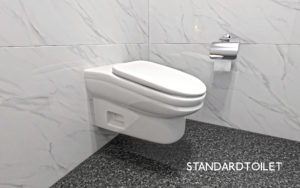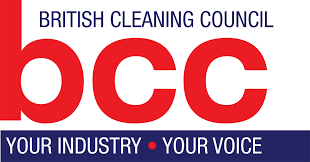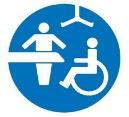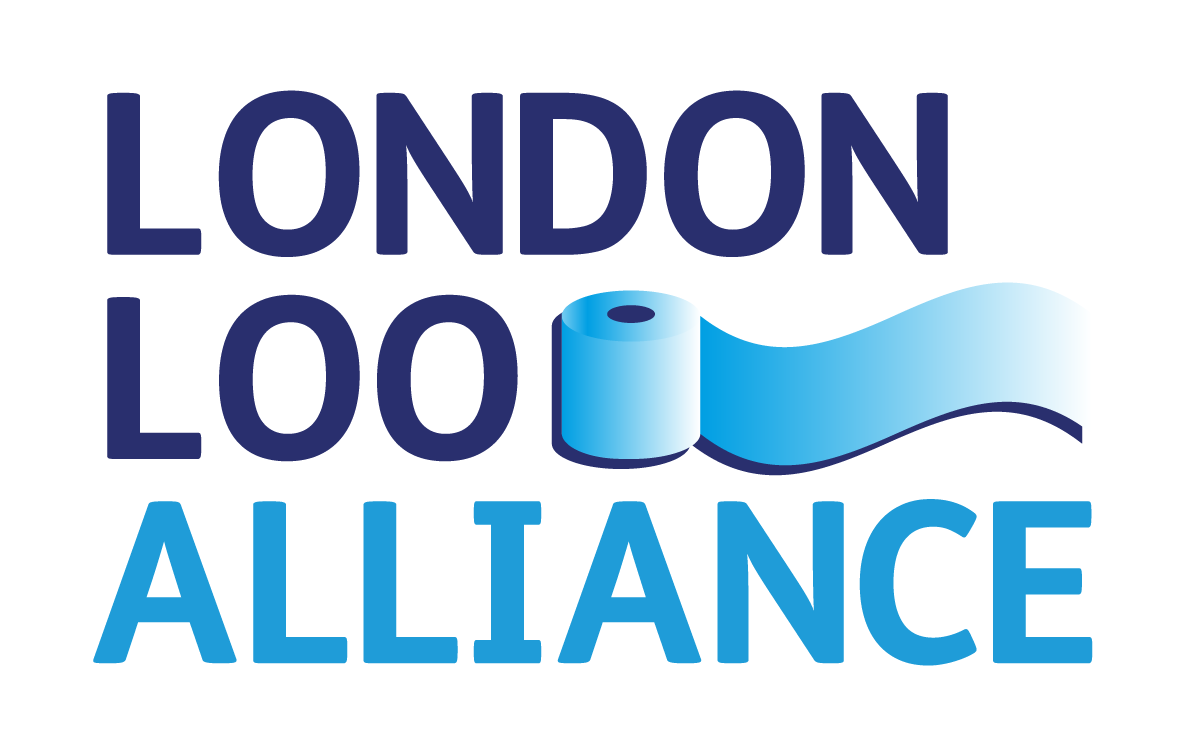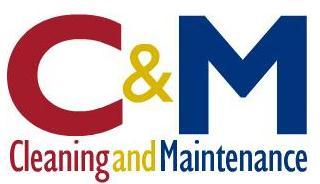Disinfecting premises using fog, mist, vapour or ultraviolet (UV) systems during the coronavirus outbreak

During the coronavirus (COVID-19) outbreak, fog, mist, vapour or UV treatments may be suitable options to help control the spread of the virus, by cleaning and disinfecting a larger space or room.
Any use of these treatments for these purposes should form part of your COVID-19 risk assessment. Users must be competent and properly trained.
Select the correct treatment
If you choose to use fog, mist, vapour or UV treatments as a way of cleaning and disinfecting surfaces, discuss your requirements with your manufacturers/suppliers (this may include fumigators), to help you decide if a product/system meets your needs. The treatment you use will depend on:
- the size of the area to be treated, its shape and how easily it can be sealed off if delivering an airborne product
- whether there are hard or soft surfaces – soft furnishings may act as a ‘sink’ for the airborne chemicals and emit them for some time after treatment (it may be possible to remove items such as sofas before treatment)
- the type of
business you have – some areas may be better suited to UV surface
treatments than airborne chemicals or vice-versa
Fog, mist, vapour method
If using the fog, mist, vapour method you will need to ensure the correct concentration of the active chemical is used, this means there is enough for it to work properly, but not so much as to leave a residue which may remain at unsafe levels for some time after treatment ends. There are different types of source disinfectants that can be applied as a fog, mist or vapour treatment. Some are liquid disinfectants used to create a fog, mist or vapour, such as hydrogen peroxide, others are generated from gases, for example ozone from air. Seek advice on what is appropriate to the environment that requires treatment.
UV method
An advantage of UV over disinfectants applied as a fog, mist or vapour is that no chemical residue is left behind. Rooms with complex configurations/interior designs may not be suitable for UV treatments due to the limitations of shadowing effects, unless multiple systems can be deployed. Similarly, very small spaces, such as small sanitary areas, may not be suitable for treatment via UV carousel as they need to be a minimum distance from walls etc to be deployed safely. Some disinfectant technologies are scalable so are typically more flexible in this respect.
Avoiding harm
Disinfectants applied as a fog, mist or vapour may reach harmful levels during delivery and UV systems may cause eye/skin damage if people enter an area undergoing treatment. Discuss with suppliers what safety features they can provide to prevent inadvertent access to a room during treatment. For example, safety sensors, simply locking rooms during treatment if feasible, or safety signage as part of a safe system of work.
Do not spray people with disinfectants
Spraying of individuals with disinfectants (such as in a tunnel, cabinet, or chamber) is not recommended under any circumstances. This practice could be physically and psychologically harmful and would not reduce an infected person’s ability to spread the virus through droplets or contact. Even if someone who is infected with COVID-19 goes through a disinfection tunnel or chamber, as soon as they start speaking, coughing or sneezing they can still spread the virus.
Do not disinfect large outdoor spaces
In outdoor spaces, large-scale spraying or disinfecting in areas such as streets or open marketplaces for the COVID-19 virus or other pathogens is not recommended. Streets and pavements are not considered as routes of infection for COVID-19. Spraying disinfectants, even outdoors, can be dangerous to people’s health and cause eye, respiratory or skin irritation or damage.
Supply and manufacture of disinfectants
The disinfectant applied as a fog, mist or vapour treatment must comply with the Biocidal Products Regulations (BPR). This includes the generation of ozone or free radicals. Please note the use of UV to disinfect is not covered by the BPR. Under BPR it is the disinfectant, or the chemical used to generate the disinfectant, added to the machine, that is the biocidal product. Please note that the machine itself is not covered by BPR. Suppliers of fog, mist or vapour units/machines should ensure that any disinfectant products they supply or recommend using with the unit/machine comply with BPR.
HSE has published separate guidance on the regulatory requirements for surface disinfectant products used, manufactured and supplied during the outbreak, which applies to disinfectant products applied via fog/mist/vapour units/machines.
Manufacturers of disinfectant products are responsible for ensuring that their products are suitably effective, including meeting any necessary testing standards. They are also responsible for providing information and instructions for the user on the product label.
The law on chemicals
Ensure that you follow the manufacturer’s instructions to ensure you are using the product safely and effectively. Where units/machines are used in a workplace, under the Control of Substances Hazardous to Health Regulations (COSHH) employers must ensure substances which may be harmful to people’s health from their work activities are identified and assessed; and processes are put in place to eliminate or control risks.
COSHH also requires employers to provide information, instruction and training for all their employees who use hazardous substances such as disinfectants in their work, including the appropriate precautions and actions employees must take to safeguard both themselves and others in the workplace.
Sealing off rooms
Rooms treated by UV or disinfectants applied as fog, mist or vapour should be empty and sealed off to avoid risk of human exposure to the potentially harmful treatments. Disinfectants may reach harmful levels during delivery and UV systems may cause eye/skin damage if people enter an area undergoing treatment. You may also consider safety sensors that can shut off UV systems if a room is inadvertently entered during treatment.
Rooms that are very difficult to seal may not be suitable for delivering airborne chemicals.
Social distancing and making your workplace COVID-secure

Social distancing means keeping people apart to help reduce the spread of coronavirus.
Where possible you should keep people 2m apart. If this is not viable, keeping 1m apart with risk mitigation is acceptable.
In the UK some rules such as social distancing may be different in each of the devolved nations. However, HSE regulates in all of these countries. You should check the public health guidance for the country you are in:
You must ensure that workers and other people visiting your workplace understand and comply with the measures you put in place.
Social distancing should form part of your business’s risk assessment and is one of the steps needed to make your workplace COVID-secure.
The gov.uk guides on working safely during coronavirus (COVID-19) explain the control measures that different types of business should consider. These cover construction, factories, offices, vehicle use and other types of work. The guides apply to workplaces in England.
The following guidance sets out the main control measures and additional measures where social distancing is not possible:
- Common areas (includes break areas, bathrooms, toilets, meeting rooms and accommodation)
- Workstations
- Arriving and leaving work
- Movement around buildings and worksites
- Where 2m social distancing is not possible
- Using vehicles
- Emergencies, security and other incidents
Common areas (includes break areas, bathrooms, toilets, meeting rooms and accommodation)
Common areas are used by many people. The potential for spread of coronavirus is considered to be higher in these areas if proper controls are not in place.
Identify and review the common areas within your workplace including:
- restrooms
- kitchens
- tea points
- changing facilities
- lifts
- meeting rooms
- smoking areas
- canteens
- toilets
- showers
- reception areas
- accommodation
Also consider pinch points in your premises such as narrow corridors, staircases, doorways and storage areas.
You may need to put in place a combination of control measures to keep people safe.
General control measures
Consider putting the following control measures in place for common areas:
- Limit the number of people at any one time using any areas that may become congested.
- Use floor markings to maintain social distancing.
- Keep surfaces clear so that cleaning can be carried out more effectively.
- Identify objects that may be touched more frequently, such as kettles, cooking equipment, phones, computers or tables and make sure that they are frequently cleaned.
- Try to maximise ventilation.
- Make sure that your workforce is clear on the rules when using common areas.
- The areas should be regularly cleaned in line with your cleaning plan.
- Minimise contact between people, using barriers or screens.
- Provide hand-washing facilities or hand sanitiser near to frequently used areas.
- Display signs reminding people to socially distance, wash hands and not touch their faces.
- Work with landlords and other tenants in multi-tenant sites or buildings to ensure consistency across areas such as receptions and staircases.
Guidance on cleaning, hygiene and hand sanitiser.
Break areas
Employers must make sure all workers, including those visiting your premises for work, have somewhere to rest and eat and should also provide facilities to heat food or water for hot drinks. Find out more about having the right workplace facilities.
Consider these control measures:
- Ensure that workers understand the need to maintain social distancing and good hand hygiene before entering any areas where food is consumed.
- If workers need to leave the site at break times remind them to maintain social distancing while off-site.
- If canteens are used, consider if food, cutlery etc can be delivered to tables. Where canteens need to serve food reconfigure seating and tables to maintain spacing and reduce face-to-face interactions. Mark the floor in case furniture is accidentally moved.
- Stagger or extend break times to limit the numbers of people using the facilities.
- Create additional break areas where required such as in unused rooms. It may be possible to create outside break areas where it is safe to do so.
Bathrooms, toilets and washbasins (welfare facilities)
You have a legal duty to provide adequate toilet and washing facilities that are easy and safe to access. This applies to any workers (including those not employed or contracted to you), and visiting workers who are not normally on your premises. The legal responsibility to provide access to these facilities lies with whoever controls the premises.
Refusing access for any reason, including as an infection control measure, is against the law. It is vital that people can wash their hands regularly, so not allowing access to welfare facilities may increase the risk of COVID-19 spreading.
When completing your COVID-19 risk assessment, review the provisions you have to make sure they allow people (including visiting workers) to social distance, use the toilets and wash hands frequently. Consider whether you need to provide any additional washing facilities.
To protect people when using existing toilet and washing facilities consider the following:
- Identify all surfaces that require additional cleaning in bathrooms and toilets.
- Taking some static facilities out of use where they are less than 2m apart. If this includes toilet facilities such as urinals you should ensure that you still have a sufficient number of toilets in your workplace.
- Put markings on floors to show people the right distances or where to stand.
- Put in place systems such as ‘one in, one out’ if it isn’t possible to maintain social distancing.
- Make sure you provide running water and soap to enable people to clean their hands properly.
- Provide hand drying facilities – paper towels or hand dryers.
- Empty bins frequently to safely dispose of waste. Where possible have open-topped bins or foot operated lids.
- Using signs and posters to increase awareness of good handwashing technique.
- Decide how and when handwashing facilities will be cleaned and when bins will be emptied.
- Decide who will replenish soap, paper towels and hand sanitiser.
Guidance on cleaning, hygiene and hand sanitiser.
Additional handwashing facilities
When completing your COVID-19 risk assessment, consider if you need to provide additional handwashing facilities so that people can wash their hands frequently.
Consider:
- where people work
- how much contact they have with others
- the frequency they should wash their hands as a result
This will also help you to decide if and where you need to provide additional washing facilities.
If you cannot provide additional handwashing facilities, you may need to provide hand sanitiser instead in some circumstances.
When you complete your risk assessment, think about:
- providing handwashing facilities at entry and exit points so people can wash their hands when they arrive and leave work – if this is not possible, provide hand sanitiser
- where extra handwashing facilities need to be to allow people to wash their hands frequently
- making sure your handwashing facilities have running water, soap and paper towels or hand dryers
- identifying where extra hand sanitiser points are needed in addition to washing facilities
Meeting rooms
Consider the following measures:
- Use remote working tools to avoid in-person meetings.
- That only absolutely necessary participants should physically attend meetings and should social distance throughout.
- Avoid sharing pens, documents and other objects.
- Provide hand sanitiser in meeting rooms.
- Hold meetings outdoors or in well-ventilated rooms whenever possible.
- For areas where regular meetings take place, using floor markings to help people maintain social distancing.
Accommodation
Employers who provide accommodation for their workers should consider the following:
- Identify measures to keep workers safe while they are staying in accommodation and working, in your risk assessment.
- Minimise numbers of people living in shared accommodation.
- Treat each accommodation living unit (eg caravan) as a ‘household’.
- How you will ensure if one person in the ‘household’ shows symptoms that all will self-isolate in line with the guidance for households with possible coronavirus infection.
- Workers should not live or stay in more than one ‘household’.
- Keep people who live in the same household together in the same work group.
- Try not to mix households while they are working.
- Try to keep each household socially distanced from other households.
- Check workers health before they start work each day.
- If a worker develops symptoms of coronavirus while working they should return to their household. The individual, and anyone else highlighted by government guidance should then follow the government guidelines on isolation.
- Cleaning regimes to ensure accommodation units stay clean.
- Cleaning regimes for shared communal areas. The employer is responsible for making sure that communal areas are properly and regularly cleaned.
- Carryout statutory checks such as landlord gas safety checks as required.
- Cleaning and maintenance regimes for toilets and showers.
- Provide fire safety precautions as normal.
Workstations
Workstations are areas where workers routinely or regularly work and can include:
- desks or tables in the workplace
- production or processing lines
- areas by machinery that workers need to operate
- desks within workers homes if they are working at home
- vehicles
Consider the following:
- Look at how you can organise workstations to allow people to meet social distancing rules.
- Review layouts and processes to allow people to work 2m apart from each other where possible.
- Use floor tape or paint to mark areas.
- Manage occupancy levels.
- Avoid any sharing of workstations, including hot desking where possible.
- Limit the number of people having to share a workstation to the absolute minimum.
- Where workstations must be shared, try to keep the same set of people using them.
- Make sure that workstations are cleared at the end of the day or shift so that they can be properly cleaned.
- Ensure that all workstations are regularly cleaned in accordance with your cleaning plan.
Where it’s not possible to keep workstations 2m apart, consider these additional control measures.
Guidance on cleaning, hygiene and hand sanitiser.
Arriving and leaving work
Consider these control measures for when people are arriving or leaving work:
- Take precautions to limit the chances of anyone with coronavirus entering your premises, for example, display signs asking people not to enter your workplace if they have symptoms of coronavirus.
- Limit the number of people entering your workplace, or parts of your workplace, to avoid overcrowding. Think about if you can you arrange partial working from home for some staff.
- Stagger arrival and departure times to reduce crowding into and out of the workplace, taking account of the impact on those with protected characteristics.
- Provide additional parking or facilities such as bike racks to help people walk, run, or cycle to work where possible.
- Provide more entry points to reduce congestion.
- Provide more storage for workers for clothes and bags. Encourage storage of personal items and clothing in personal storage spaces, for example lockers during shifts.
- Use markings and introduce one-way flow at entry and exit points.
- Provide handwashing facilities at entry and exit points, or hand sanitiser where handwashing is not possible. Make sure you provide these facilities for anyone entering your workplace.
- Where possible, avoid using touch-based security devices such as keypads. If you need to use them, make sure they’re cleaned regularly.
- Where possible, introduce shift working to limit the number of people in the workplace at any one time. This may also reduce the burden on public transport if your employees use it to travel to work.
- Where possible, introduce suitable barriers or screens where people regularly interact, such as service desks or reception areas. If used, ensure they are cleaned and disinfected in line with your cleaning procedures.
- Put in place procedures for dealing with deliveries and visitors. Allocate time slots for customers.
- Put in place measures to keep delivery drivers safe, this includes allowing delivery drivers to use welfare facilities.
Guidance on cleaning, hygiene and hand sanitiser.
Movement around buildings and worksites
Consider these control measures when people are moving around buildings or worksites:
- Use floor markings to mark out social distancing. Focus particularly on the most crowded areas, for example where queues form, entry points to buildings, toilets and communal break areas. Additional control measures may be needed for areas at higher risk of overcrowding, such as common areas.
- Use any unused spaces to allow people to spread out and comply with social distancing rules.
- Reduce movement by discouraging non-essential trips within buildings and sites, for example restricting access to some areas, encouraging use of radios or telephones or other electronic devices, where permitted, and cleaning them between use.
- Restrict access between different areas of a building or site.
- Reduce job and location rotation.
- Introduce more one-way flow through buildings.
- Reduce maximum occupancy for lifts. Provide hand sanitiser for the operation of lifts. Encouraging use of stairs wherever possible.
- Make sure that people with disabilities are able to access lifts.
- Manage the use of high-traffic common areas including corridors, lifts turnstiles and walkways.
- Put in place measures to remind staff and visitors to follow social distancing.
Where 2m social distancing is not possible
Consider these additional control measures where 2m social distancing is not possible:
- Consider if the activity needs to continue or if it can stop.
- Keep the number of people working who cannot social distance to a minimum.
- Reduce the number of people in close proximity in the work area.
- Limit the movement of people around the site. Consider if workers stay in one place, or at one workstation when working.
- Limit the amount of different equipment or surfaces that people need to touch.
- Assign workers to teams which then socially distance from other teams. Keep workers in the same teams as far as possible to limit social interaction. Keep teams as small as possible. If a team member becomes ill with symptoms of coronavirus, they and the rest of the team should follow the UK government guidance on self-isolation.
- Use screens between people to create a physical barrier. You should keep the screens clean.
- Organise the space so that people are side-by-side or facing away from each other rather than face-to-face.
- Mark the floor of areas such as lifts to show where people should stand and what direction they should face.
Guidance on cleaning, hygiene and hand sanitiser.
Using vehicles
On gov.uk there is guidance for people who work in or from vehicles setting out control measures to help protect workers.
Consider the following control measures:
- If travel in vehicles is needed for the business to continue to operate.
- Ensure those who are travelling are necessary for the work to be carried out.
- Limit passengers in corporate vehicles such as work minibuses. This could include leaving seats empty.
- Consider if social distancing measures can be implemented in the vehicle.
- Avoid multi-occupancy vehicles where safe to do so.
- Where multi-occupancy vehicles are used, people should social distance where possible through suitable seating arrangements and where necessary, use of additional transport. Keep the journey as short as possible.
- Where more than one person is travelling and they need an overnight stop, plan ahead to ensure there is suitable accommodation secured to ensure social distancing.
- Consider if people who need to travel in vehicles can be kept in the same teams.
- Consider if vehicle windows can be kept open.
- Ensure that people practice good hygiene before and after using the vehicle. Provide hand sanitiser where necessary.
- Vehicles should not be shared between different users if possible.
- Remind workers to travel alone to and from work where possible, either in their own transport, by walking, or cycle if it is safe to do so.
- Ensure vehicles are cleaned regularly, in particular between different users. Clean commonly touched areas in vehicles including:
- handles (inside and out)
- steering wheel and starter button
- centre touchscreen and stereo
- handbrake and gearstick
- keys and key fob
- indicators and wiper stalks
- windows, mirrors and mirror switches, seat adjusters any other controls
Where it’s not possible for people to social distance in a vehicle, consider additional measures such as:
- using physical screening, as long as this does not compromise safety, for example by reducing visibility
- sitting side-by-side not face-to-face
- using a fixed pairing system if people have to work in close proximity
Drivers’ welfare at delivery and collection sites during the coronavirus (COVID-19) outbreak
Emergencies, security and other incidents
Consider the following:
- Reviewing your incident, first aid and emergency procedures to ensure people can social distance as far as possible.
- Considering the security implications of any changes you intend to make to your operations and practices in response to the coronavirus outbreak as any revisions may present new or altered security risks.
- For organisations who conduct physical searches of people, considering how to ensure safety of those conducting searches while maintaining security standards.
Public Lavatories Bill unanimously passes second reading in Parliament
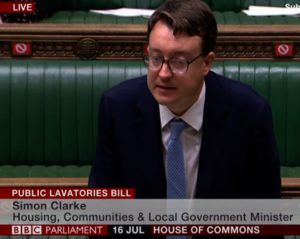
Minister Simon Clarke MP, from the Ministry of Housing, Communities and Local Government presents the Non-Domestic Rating (Public Lavatories) Bill 2019-2021 to the House of Commons today. The Bill received unanimous approval, for adoption, by the ministers present. When brought into legislation it will effectively remove the levy of (NDR) Rates from all “stand-alone” public toilets in England and Wales. The devolved administrations will be expected to adopt the new Act.
The Hansard Transcript of the proceedings can be read in full by following this LINK:
The BTA is delighted to annoounce the long awaited progress of the NDR Bill to remove the rates levy from all “stand-alone” public toilets. Our founder and current President Richard Chisnell took up this baton in 2012 and it has been an arduous journey through the years to get to this point. In 2015 the BTA board agreed to make this relief a priority and Roger Berry took the lead in speaking to likeminded organisations and political colleagues to try and move the proposal forward.
October 2018 the Chancellor of the Exchequer Mr Philip Hammond announced, during his budget speech, in Parliament that he was introducing the NDR Public Lavatories Bill and following the Bill passsing through the House of Lords and the House of Commons we’re almost there.
The Bill will now go forward immediately after the summer recess of Parliament and be laid before the House of Lords for their final approval before hopefully progressing to Royal Assent to become an Act of Parliament and enter into our Primary Legislation.
Local Authorities will be able to claim a FULL rates allowance relief on all Publicly Accessible Toilets under either their or even private control and use the monies saved to upgrade their services and provision of existing facilities. The minister thanked a number of organisations including the BTA, NALC and RSPH for their support and help in campaigning for this change in future legislation.
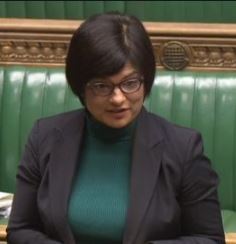
Thangam Debbonaire, the Shadow Secretary of State for Housing, lead those ministers present in congratulating Mr Clarke for presenting the Bill and the government for strongly supporting its immediate adoption – but suggested that there were still further enhancements called for. She agreed that this was a great first small but important step to retaining and restoring these essential buildings – but asked if government could look at the numbers of toilets lost over previous years and perhaps use some Covid emergency funding to redress the loss. Many public buildings, such as libraries, museums ansd civic centres were excluded under this pending legislation and she again asked if consideration might be given to how these additional local amenieties could be included, at some future juncture.
The Minister also proposed that, due to the keen support from many ministers and colleagues, that a working group should be established to look at the wider range of issue around provision of Public Toilets for all citizens, especially those with severe medical, emotional and physical conditions who relied daily on finding urgent relief when moving away from home. Ministers highlighted the plight of all those persons working away from their bases, lorry, coach, bus and taxi drivers and alos those in emergency services and social care who rely on these essential facilities. The Minister kindly thanked the BTA for providing some information and guidance on the essential and vital role played by publicly accessible toilets throughout society and the nation.
With the increased demands being placed upon these vital provisions following the easement of lockdown it is now critical that we see immediate investment in upgrading and reopening these frontline services. As we try to rebuild our local economies and invite tourism back to our towns and villages were have to invest time, money and expertise in getting our publicly accessible toilets hygienically cleaned and safe for use.
Both Minsters praised the national Changing Places programme and the work that BTA have been committed to with Muscular Dystrophy UK and Pamis in Scotland; in creating the CP Map and identifying potential new sites. Substantial funding of £30million has already been agreed to expand the reach of this programme and to greatly increase the number of sites where these specialised rooms can be best utilised.
The British Toilet Association wishes to thank all those individuals, groups and organisations who have worked closely with ourselves and our member organisations over the years to help bring about this relief legislation to local authorities.
We offer our special thanks to everyone who continues to fight tirelessly for the national retention of publicly accessible toilets and the future upgrading of our “away-from-home” toilets and the increasing standards of hygiene and provision — for ALL USERS.
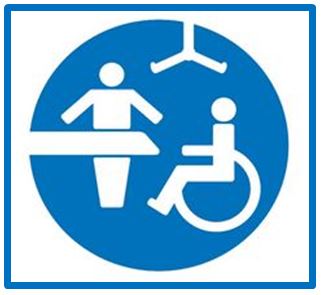
CHANGING PLACES CAMPAIGN
The BTA Director and the Board are fully committed to working with our colleagues in the Ministry of Housing, Communities & Local Government, Muscular Dystrophy and Pamis to support, maintain and expand the Changing Places Campaign, the CP Mapping System and the continued natonal drive for NEW facilities.
Coronavirus (Covid-19) BTA GUIDELINES

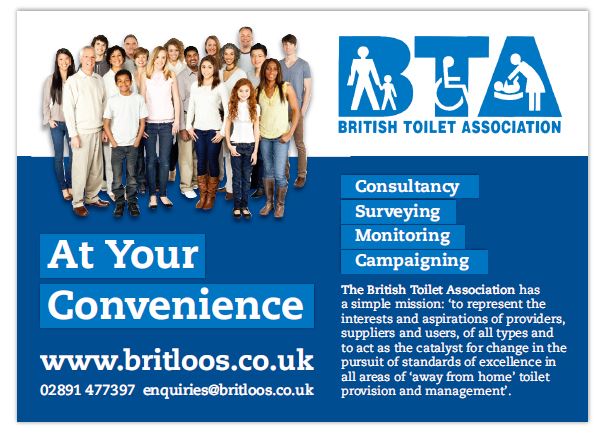
The BTA has been continuing to work throughout the pandemic to offer advice and guidance to all our members as well as providers and suppliers; on the importance of publicly accessible toilets. Each day we have been talking with experts around the world on cleaning and hygiene technologies and methodologies – WOW it;s been a steep learning curve !
This virus is posing a lot of questions on HOW do we kill it – WHAT do we use to kill it, HOW often do we apply product and/or WILL it return.
The government has offered little if NO guidance other than Hand washing and really hasn’t put any serious thought into the effects or long-term battle. From our research to date we are beginning to understand the quickest, safest and hopefully most effective methods to treat surfaces.
1. STEAM – high pressure steam cleaning will certainly kill the virus. So opening up a toilet block using this method offers the best results. It’s then a matter of how many times you can repeat this process.Some cleaning companies are using Hand-Held steaming devices to get into tight recesses
2. UV LIGHT – is very effective on all viruses (including Covid19) and can be applied using a hand-held wand. Care must be taken to apply the light for a period of several seconds on specific areas – as it takes a few moments for the UV to do its job. We have seen larger industrial units that circulate air through a UV prism which is very effective – but the cost of these is in excess of £3k.
3. One of our BCC colleagues helped to set up the Nightingale Hospital in Glasgow and her role was to train the cleaners. She went at length to maintain that good thorough cleaning with mild detergents or simple soap/fluid and hot water was just as effective. Again the importance of continued cleaning was the absolute key to maintaining a high level of hygiene.
4. BLEACH — I know it’s a forbidden substance in many councils – but it certainly kills Covid-19. We are aware that in these extremely threatening times that many cleaning operatives (fearing for their own safety as well as wanting to keep the public safe) may be resorting to using a mild/diluted solution to make sure that the surfaces are clear and free from this deadly intruder. We’re not condoning it – just putting it out there.
As you would expect, we are being bombarded with a range of products that companies would like us to endorse — but you will all understand that we cannot specify any particular brands or technologies until we have verified the bench tests & clinical trials — and in most cases that is probably many months away. So we are planning to feature some products ad processes that might give you ideas and concepts to persue yourselves.
We have repeatedly asked this government for the opportunity to lead a team of specialists/experts in working to find clear and correct solutions for the vast array of issues regarding public toilets. Everything from:
Surfaces (a complete range of different types..wood,plastic,stainless steel, formica, paint etc..) and we need to understand how long the virus lives on each – if it is affected by heat/light/cold/rain.wind ??
Touch Points – handles rails, flushes, taps, dispensers, door bolts, partitions Airflow – warm air dryers, aircon systems, windows and ventsSoap – non touch dispensers – replacing with sanitizing liquid – charging
External Sanitizing stations – for members of the public who don’t need the loo or at remote locations
Entry & Exit points – how do people enter and leave the facility – how do we want them to? Clinch/Pinch points? Control and Security
We have raised the issue of emergency funding to get these units brought up to an acceptable standard – perhaps even upgraded – to date there has been absolutely NO response.
We have raised further concerns on the projected increase in tourism and “STAYCATIONS” this year particularly. If our citizens are too scared to travel abroad to other countries for fear of catching any 2nd wave — then it is fair to assume that many may choose to visit the beautiful hills, valleys and seaside resorts of this country and therefore significantly increased numbers will expect to find the toilets open, clean and fit-for-purpose,
As there is still no PRIMARY or STATUTORY LEGISLATION, and more fundamentally no direct FUNDING that compels Local Authorities to to provide Publicly Accessible Toilets then we will continue to see councils struggling to provide clean, hygienic facilities across the country.
The government has been repeatedly asked to make “Emergency Funding” available to get these units reopened and more importantly upgraded to an acceptable standard to hekp fight the current & future viral threats. But again they have failed to respond or focus on these vital facilities. Several letters have been sent to various politicians asking them to address this issue and to make available some revenue to help councils to fight this dangerour viral threat by bringing these essential services up to speed and ready to facilitate the public in the quest for increased hygiene & safety.
£8.2 billion has now been granted to help fight this pandemic and to get the country’s economy flowing again. Without the legislation or requirement for councils to provide decent clean public toilets – many will choose to spend these monies on their mandatory services and long term contracts and our essential facilities will fall further into decline – placing all of us at increased risk of not being ale to find relief or hand-washing facilities when we most need them. Those councils who understand and embrace the need for public toilets have already indicated a substantial rise in the cost of entry — prices will rise to perhaps 50p – £1.00. Many units will move to “card only” access to prevent further contamination from coins. Customers will have to accept that this revenue will surely be needed to sustain the expected levels of hygiene and maintenance in the coming months and years ahead. It might also help to eradicate the problems that many councils are having with homeless sleepers and anti-social activities (including drugs)
BTA continues to work with the British Cleaning Council (BCC) and the British Standards (BSI) to review policies and directives to cleaning operatives, suppliers and providers. Primarily we’re all remote working so contact time is limited and many elements are taking longer to get sign-off or final agreement. The BSI has produced a “Safe working during Covid-19 pandemic” guidance document for orgaisations – follow the LINK below
BSI Guidance on: Use of toilets
The organization should consider additional measures to facilitate the safe use of toilet facilities (including Changing Places toilets used by disabled people) by workers and other interested parties. Actions can include:
a) managing the use of toilet facilities to avoid crowding;
b) establishing more frequent and enhanced cleaning (including touch points such as toilet seats, locks, flushes, grab rails, hoists) and waste disposal;
c) limiting the number of cubicles and urinals available in a block of toilets, to promote physical distancing;
d) using signage to encourage users to close toilet lids before flushing, where lids are fitted;
e) ensuring a system is in place to allow queues for toilets to form outside of the facility rather than in the confined space;
f) requesting workers or visitors to use a single designated set of facilities within a workplace, taking into account users with special needs who cannot comply with this;
g) providing paper towels or electric hand dryers, and ensuring levels of paper towels are monitored and maintained and that there is frequent, safe disposal of waste;
h) using automatic rather than manual equipment (e.g. sensor operated taps, soap dispensers, flushes, foot-operated bins); and
i) increased monitoring and replenishment of supplies (e.g. soap, sanitizer, paper towels, toilet paper).
.
As always, I would be delighted to discuss and expand any of the points raised or still causing you any concern. You have my numbers – and I would welcome a call. Please stay SAFE and ALERT!
Coronavirus (Covid-19) England
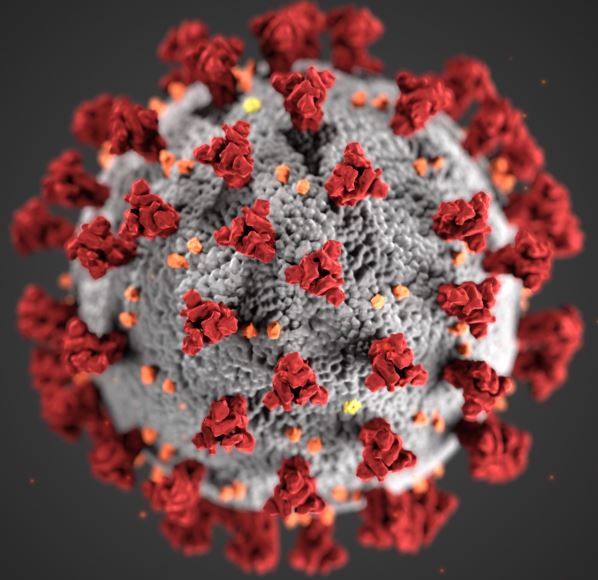
Since the arrival of this pandemic it has become extremely clear that each and everyone of us has to adhere to an increased level of personal hygiene. Regular hand washing and the repeated use of anti-bacterial wipes on the surfaces we come into contact with are essential precautions to avoid the spread of this deadly threat.
As the Lockdown eases and we venture back into society or return to our places of work we face the added strain of cross contamination and potential transmission of this virus to colleagues and friends. So we are looking for guidance from the devolved administrations to help us all act and behave in a responsible way to avoid touching contaminated surfaces or leaving traces behind that could be harmful to others.
Publicly Accessible Toilets are a vital piece of our everyday lives and these essential facilities help us to stay comfortable and relieved when we travel away from our homes or places of residence. The government has clearly advised us all to WASH your HANDS reguarly and thoroughly for a least 20 seconds after coming in contact with any area or surface that might host the virus. So PC’s are an absolutely vital piece of infrastructure in our fight against Covid19 and these units must be opened and maintained to the highest levels of hygiene and cleanliness to serve the rising needs.
Unfortunately, many public and retail units remain closed dur to the severe lack of CLEAR & CONCISE guidance from government and the fear of the providers and sppliers that they are effectively combating the viral threat.
NEW GUIDANCE RELEASED
In the last fe days we have received a set of guidance outlines from the English, Scottish and Welsh governments towards getting Public Toilets reopened and fit for public use. The LINKS below will take you directly to this advice and should allow you to make most of the daily routines and decisions around opening these essential facilities.
However, please remember that Covid19 only arrived some 3 5 months ago and much is still unknown about the DWELL times and EFFECTIVENESS of many substances and procedures in removing or killing this viral threat. We have offered our thoughts and understandings below – but you mmust be guided by the governments direct Coronavirus briefings and the special Scientific Advisors who are working tirelessly on your behalf to find the most effective controls and remedial work to attack and neutralise all aspects of this threat to our very existance.
Guidance on Opening Pubic Toilets
from Simon Clarke MP Minister for Regional Growth and Local Government
and Rebecca Pow MP Minister for the Environment
Public toilets, portable toilets and toilets inside premises should be kept open and carefully managed to reduce the risk of transmission of COVID-19. Steps that will usually be needed:
- Using signs and posters to build awareness of good handwashing technique, the need to increase handwashing frequency and to avoid touching your face, and to cough or sneeze into a tissue which is binned safely, or into your arm if a tissue is not available.
- Consider the use of social distancing marking in areas where queues normally form, and the adoption of a limited entry approach, with one in, one out (whilst avoiding the creation of additional bottlenecks).
- To enable good hand hygiene consider making hand sanitiser available on entry to toilets where safe and practical, and ensure suitable handwashing facilities including running water and liquid soap and suitable options for drying (either paper towels or hand driers) are available.
- Setting clear use and cleaning guidance for toilets, with increased frequency of cleaning in line with usage. Use normal cleaning products, paying attention to frequently hand touched surfaces, and consider use of disposable cloths or paper roll to clean all hard surfaces.
- Keep the facilities well ventilated, for example by fixing doors open where appropriate.
- Special care should be taken for cleaning of portable toilets and larger toilet blocks.
- Putting up a visible cleaning schedule can keep it up to date and visible.
- Providing more waste facilities and more frequent rubbish collection.
The above shows the complete lack of understanding of the myriad of issues surrounding the reopening of public toilets and the problems and fear that these providers are facing in allowing large numbers of persons into their premises to use these facilities. They give no guidance to cleaning regimes or materials, chemicals, processes or clinicaL RESEACH that would provide reasonable guidance and understanding that the correct procedures were being observed and carried out.
We suggest that you read and digest the more concise guidance that is being proffered by the Scottish and Welsh governments which goes into a more clear description of processes – but may still lack the clinical details that many are seeking. The BTA guidance that follows tries to give some additional information on cleaning methodlogy and processes and offers advice that suppliers and providers might use to seek professional help from outside professional sources – such as HSE or Dept of Health or Public Health.

Additional Guidance on deep-cleaning is given from our colleagues at the Health & Safety Executive (HSE) on the use of various mist, fogging and UV sysytems. All is contained within a further POST on this site or please follow the LINK directly to the HSE website,
Coronavirus (Covid-19) Wales
Since the arrival of this pandemic it has become extremely clear that each and everyone of us has to adhere to an increased level of personal hygiene. Regular hand washing and the repeated use of anti-bacterial wipes on the surfaces we come into contact with are essential precautions to avoid the spread of this deadly threat.
As the Lockdown eases and we venture back into society or return to our places of work we face the added strain of cross contamination and potential transmission of this virus to colleagues and friends. So we are looking for guidance from the devolved administrations to help us all act and behave in a responsible way to avoid touching contaminated surfaces or leaving traces behind that could be harmful to others.
Publicly Accessible Toilets are a vital piece of our everyday lives and these essential facilities help us to stay comfortable and relieved when we travel away from our homes or places of residence. The government has clearly advised us all to WASH your HANDS reguarly and thoroughly for a least 20 seconds after coming in contact with any area or surface that might host the virus. So PC’s are an absolutely vital piece of infrastructure in our fight against Covid19 and these units must be opened and maintained to the highest levels of hygiene and cleanliness to serve the rising needs.
Unfortunately, many public and retail units remain closed dur to the severe lack of CLEAR & CONCISE guidance from government and the fear of the providers and sppliers that they are effectively combating the viral threat.
NEW GUIDANCE RELEASED
This guidance is primarily for owners and operators of toilets for public use in Wales
- Local Authorities, town councils and town/city centre managers/forums
- Town and Community Councils
- National Parks
- Third sector organisations
- Heritage and tourism sites
- Commercial or business premises where toilet access is provided to the public
- Hospitality sector (e.g. cafés, bars, restaurants)
Where sector specific guidance is also available it should be considered alongside this.
Purpose and scope of this guidance
The Health Protection (Coronavirus Restrictions) (Wales) Regulations 2020 (as amended) have been made for the purpose of preventing, protecting against, controlling or providing a public health response to the spread of Coronavirus and contamination in Wales. The Regulations currently require certain premises and businesses to close, whilst imposing restrictions on certain businesses or services (including ‘public toilets’) allowing them to remain open providing that those responsible take all reasonable measures to ensure that specific physical distancing requirements are maintained. Persons responsible for work carried out on certain premises are also under a duty to take all reasonable measures to ensure that a distance of 2 metres is maintained between persons on the premises. Those subject to a requirement to take all reasonable measures must have regard to guidance from the Welsh Ministers about taking those measures. These Regulations are regularly reviewed in accordance with Regulation 3.
This guidance focuses on the safer management of toilets for public use in the context of the Coronavirus pandemic and in compliance with the Coronavirus Restrictions Regulations. It is intended to help the owners and operators of toilets for public use to plan for the safer management of toilets as the restrictions in Wales are lifted and to plan for the re-opening of toilets where they have been closed.
This guidance provides a framework for identifying the issues associated with the use of toilets for public use in light of the need for social distancing and cleaning/disinfecting to minimise the transmission of the virus.
This guidance sets out additional principles that owners and operators of toilets for public use will need to consider. It does not replace any existing health, hygiene, risk assessment or other requirements for the normal safe management of toilets for public use.
Responsibility in Wales for opening / managing toilets for public use rests with the toilet owner or operator. For some assets, the local authority may be the owner but responsibility for the operation and maintenance rests with some town or community councils under a lease agreement as part of asset transfer agreements.
Under the Public Health (Wales) Act 2017, there is a duty placed on local authorities to have a local toilet strategy and statutory guidance has been provided. Under part 8 of the Public Health (Wales) Act 2017, local authorities may provide toilets in its area for public use.
This guidance does not alter those duties and powers, it merely provides advice and principles owners / operators may want to consider.This publication has been prepared by the Welsh Government, developed with advice from technical experts and from local authorities. This guidance applies in Wales only and does not impose any legal obligations.
Public health is devolved in Scotland, Wales and Northern Ireland. For advice in other parts of the UK please see guidance prepared by the Northern Ireland Executive, the Scottish Government and, for England, the UK Government (Ministry for Housing, Communities and Local Government). We expect this document will be updated over time – this version is up to date as of 2 July 2020. You can check for updates on the Welsh Government website.
If you have any feedback regarding the content of this document and inform future guidance, please email saferplaces@gov.wales. This guidance is part of a wider set of documents produced by the Welsh Government about safer public places and related issues. All Welsh Government guidance can be found on the Welsh Government website.
What this guidance contains
The guidance contains principles and steps owners and operators of toilets for public use should consider in planning the reopening (where toilets have been closed) and management of toilets as safely as possible. It does not replace the need for owners and operators to carry out their own risk assessments or follow normal toilet cleaning and management practices.
Existing Public Health Wales and Welsh Government guidance covers the principles of how to manage toilets from a health and hygiene perspective, including the re-opening of schools and other educational settings, managing Safer Public Places and workplace guidance. What this guidance does is bring together those health and hygiene principles in one place, and also consider the issues particular to toilets for public use around public access and communications. See Further information for links to the related guidance.
The importance of re-opening toilet facilities
Toilet accessibility is a key factor in easing restrictions and restoring confidence, once it is safe to do so. Many publically accessible toilets have closed in the response to the pandemic, which has helped encourage people to stay local. Toilet access is essential for many people including the elderly, those classed as disabled, those who are pregnant, those with young children, or those with medical conditions. Consideration should be given to the equality implications of those with particular health needs who need to use the toilet more often. Equality Impact Assessments should be reviewed as part of the planning for re-opening toilets. A lack of toilets can result in anti-social behaviour.
As the coronavirus restrictions are lifted the increasing number of local people and tourists is likely to place pressure on services including toilets for public use. Toilets are currently in the ‘high priority but high anxiety’ area for the public – half will not visit an attraction at all if toilets are closed. Assurance of safety measures are hugely important in building confidence in their use, and toilet information is key for pre-visit communication. Many people feel they cannot leave their homes for shopping or other day to day tasks if they do not know that a toilet is available.
The challenges of re-opening toilet facilities
Toilets are potentially a risk for transmission of the virus if not managed well. Toilets for public use vary hugely, from isolated rural facilities to small community facilities to large blocks in city centres. Some toilets for public use are located in hospitality / tourism and other public and commercial facilities etc. Toilets are usually relatively enclosed indoor spaces and are often unsupervised. The virus is unstable and does not transmit as easily in outdoor environments and is rapidly inactivated by heat and sunlight. Indoors the virus is likely to survive for longer.
Social distancing and hygiene
Current guidance issued by the Welsh Government focuses on the key messages to keep Wales safe by:
- always observing social distancing (also known as physical distancing) – stay 2 metres (3 steps) away from others (outside your immediate household), indoors and outdoors;
- wash your hands regularly;
- if you are meeting one other household, stay outdoors;
Read Welsh Government social distancing guidance.
Enhanced cleaning and disinfection practices should be followed.
Read public health guidance on cleaning and disinfection in non-healthcare settings.
In Wales there is no legal or mandatory requirement for people to wear face coverings in public.
Good practice steps to consider
Consideration should be given to the sections below taking into account local conditions, location, size, usage of toilet etc. Risk assessments should be undertaken by owners / operators before opening any toilet, and then kept under review. Risks assessments must include consideration of staff safety and any additional workforce impacts in managing and cleaning toilets. These points are over and above all normal toilet management requirements.
Hygiene – cleaning and handwashing
- Frequent enhanced cleaning and disinfection regime adhering to guidance particularly of points that are regularly touched. Frequency will be determined by owners / operators risk assessment based on likely volume of use.
- Frequent collection of paper towel and other waste.
- Minimising use of portable toilets (non mains sewage/proximity of waste/enclosed space) whilst acknowledging that at some sites it may temporarily be the only option (i.e. while other facilities remain closed).
- Using signs and messages to build awareness of good handwashing technique and other respiratory hygiene behaviours, e.g. around coughing and sneezing in public places.
- Best practice handwashing information and facilities should be provided
- Where possible, providing disposable hand towels as an alternative to hand dryers in handwashing facilities.
- Where appropriate, sufficient and accessible provision of automated hand sanitising dispensers.
- Regular checking of facilities and measures including recording of checks.
See Further information for guidance on cleaning and disinfection in non-healthcare settings.
Social distancing
- Clear signage should be provided on the requirement to maintain a 2m distance from others (outside of your immediate household).
- Measures to limit the number of users at any one time, perhaps a one in one out system, either self-regulated with clear signage, or overseen by an attendant.
- Removing access, for example to every other urinal or hand basin through use of tape or signage or other mechanism.
- Clear markings for distancing and queuing.
- Where possible doors to toilet blocks may be wedged open to maximise fresh air, to allow users to assess numbers inside, and to limit hand contact.
Communication
Toilet signage
Clear bilingual signage with simple messages should be used:
- Do not use toilets for public use if you have symptoms of COVID-19
(stay home, self-isolate, seek a test) - Use them, wash your hands and leave promptly.
- Avoid unnecessary touching of internal surfaces, fixtures and fittings.
- Keep a 2m distance from others outside your own household – observe social distancing and hand hygiene guidance at all times.
- Queue outside not inside the toilets.
- Where provided – use hand sanitiser before entering and after leaving.
- Guides to good handwashing and around coughing and sneezing in public places.
- Telephone number if any cleanliness or stock issues.
Information Campaigns
Consider publically available information / publicity on:
- Toilet opening and cleaning protocols so people can plan trips and to help restore confidence.
- Reinforcing the responsibility of members of the public to follow the rules on social distancing and hygiene.
Consideration of all user groups
- Equality Impact Assessments should be reviewed to ensure that the way rules are implemented do not have a disproportionate, negative impact on those who share protected characteristics. Particular consideration should be given to those who are visually impaired in terms of signage and communication.
- Consideration should be given to opening Changing Places toilets as a priority.
- Larger toilets or those in busier areas may require supervision, at least in the initial stages, to ensure public are adhering to social distancing and to restrict the number of people using the facility.
- In some locations toilets are looked after by volunteers many of whom will be in the at risk or extremely vulnerable (shielding) categories so alternatives may need to be found.
- Training of any personnel involved in delivering the measures will be key to ensure they understand and can communicate local guidance effectively and positively.
- Where a decision is made not to open a toilet for public use (particularly baby change facilities, toilets for the disabled or Changing Places) an Equality Impact Assessment should be undertaken to assess impacts on accessibility to all sectors of the community.
Queuing
- Defined areas and clear signage to indicate where pedestrians should stand when queuing using spray markings or temporary barriers.
- Management of multiple queues for different entrances through clear signage and the use of stewards as appropriate.
- “Do not join the queue, come back in xxx minutes” signs provided at popular destinations, when capacity reached.
- Alternative provision and / or seating for people who are unable to stand for long periods.
- Protection of queues through physical security measures / street furniture.
Coronavirus (Covid-19) Scottish Guidance

The opening of public toilets carries with it a risk of transmission of COVID-19 given the low levels of natural light, lack of ventilation, many surfaces to touch and the purpose of a toilet. Therefore, there is a need for careful consideration of how public toilets can be opened as safely as possible.
Safe opening will vary according to specific sectors and should align to the
guidance provided by those sectors in terms of restart. Assurance that adequate
sanitary facilities can be provided where appropriate is integral to the
restart process.
Public toilets are defined as any toilets accessible to the public. The opening of toilets should be accompanied by local risk assessment, and control measures should be proactively monitored by operators. Most premises should have a norovirus policy that can be adapted for use in cleaning facilities if an individual with COVID-19 symptoms is known to have used the facilities.
Risk assessment should specifically include:
- remote/unmonitored facilities for which there may be increased demand as travel restrictions are eased and people start travelling greater distances
- janitorial
staff for whom operators should already have procedures/PPE in place
Any
modifications or changes must take existing regulations into account.
Regulations on the provision of public toilets are governed by a number of
British Standards developed by the British Standards Institution (BSI). The key
standards which apply to the provision of public toilets are BS 6465 parts 1-4
and BS 8300 for accessible units
In opening toilets, operators should:
Prior to opening:
- conduct routine checks and take all measures appropriate to reopening after a prolonged closure e.g. consideration of requirements for legionella risk management due to stagnant water in plumbing systems
- adjustments must be made such as signage, taping off areas and floor markings to ensure physical distancing and facilitate good hand and other hygiene
- review all toilet and sanitary facilities (including disabled and baby change areas) to determine whether the fixtures and fittings are in good working order and replace or repair if not
- consider the need for additional waste management arrangements
Enhanced cleaning
It should not be assumed that hygiene measures in place pre-COVID-19 will be sufficient. Enhanced cleaning is likely to be required and should take into account:
- frequency – should be increased beyond what has been the case before COVID-19 and should be based on a risk assessment which includes both the usage of the facility and the fact that COVID-19 survives on the hard surfaces present in toilets for at least 72 hours
- products used – should be a disinfectant not detergent-based product
- areas of particular concern – it is important that attention is paid to frequently touched areas including toilet flush, toilet seat, toilet locks and handles, taps, paper towel and soap dispensers and door handles on access/entry
- enhanced monitoring of facilities will be required to ensure hygiene is maintained
- clearly display enhanced cleaning rota and ensure it is adhered to i.e. a documented record that the checks have been carried out for the public to see
- the cleaning rota should be supplemented with a cleaning schedule or similar procedure log that details the manner and frequency of cleaning of the various surfaces
- remove any unnecessary or communal items within the facility (e.g. ornaments or cosmetic items) to facilitate cleaning
- ensure that if a staff key fob or key is required to access the facilities this is cleaned between uses
- PPE should be provided in line with Health Protection Scotland Guidance for General (Non-Healthcare) Settings
- staff should be trained in appropriate cleaning methods for sanitary areas and the use of the equipment and products for cleaning and disinfection
- special care should be taken with the cleaning of portable toilets
Equipment
- reusable equipment should be removed and replaced with disposable (e.g. fabric towels, baby-changing mats)
- ensure that there are adequate hands-free waste disposal units
- cleaning materials for surfaces should be provided (e.g. antibacterial wipes for baby change areas)
Communication
- use signs and posters to: build awareness of good handwashing technique and reinforce the need to increase handwashing frequency, to avoid touching your face; and to cough or sneeze into a tissue, which is binned safely, or into your arm if a tissue is not available
- consider providing a contact number for the public to use should they have any concerns regarding cleanliness (e.g. if the facility has been heavily soiled between cleans). Use signage to tell the public what to do if someone falls ill with suspected COVID within a toilet facility
- COVID-19 can present with diarrhoea and or vomiting therefore it is important to have a mechanism to ensure the facility can be closed and adhoc cleaning can be arranged should the need arise
Hand hygiene
- provide liquid soap and ensure there is adequate stock at all times
- consider providing hand sanitiser dispensing units in portable toilets where handwashing can be less effective
- consider adjusting the time that push/sensor taps are on to encourage 20 seconds of hand washing
- provide hand-drying facilities – either paper towels with appropriate and frequent waste disposal or electric hand driers
- reduce the requirement for surfaces to be touched once hands have been washed on the way out of facilities e.g. prop open exit door
- consider providing hand sanitiser gel at the entry and exit from the facility. With adequate hand washing, the contamination of contact surfaces on leaving the facilities should be minimised. However, we know that many people do not wash their hands properly
Physical distancing
- operators should consider how to limit the number of people within facilities with multiple stalls/urinals e.g. with signage on the door instructing users to wait outside if they find that the facilities are occupied
- physical distancing should be maintained by way of signage and floor markings and, in respect of staffed toilets, proactively encouraged by staff
- consider whether additional measures such as physical barriers are required e.g. cubicles provide barriers but wash basins and urinals (trough urinals, in particular) will require greater consideration
- consider whether distances between equipment e.g. hand basins are sufficient and consistent with physical distancing policy
- consider the route to and from toilets, in particular how to maintain physical distancing and cleaning of possible touchpoints
- use one-way systems where this is possible
Sanitary facilities provision
- where toilets are being provided for a specific event, consider whether the standard guidance on toilet to person ratios needs to be revised to allow for physical distancing and enhanced cleaning routines
- note that more toilet facilities may be needed for the same number of people due to the physical distancing and hygiene measures
- note that there may be a greater number of people who need to use public toilets than usual as behaviours are influenced by current guidance (e.g. more people meeting in parks)
Following opening, there should be regular and proactive inspection of facilities to detect and address any issues promptly.
World Toilet Day
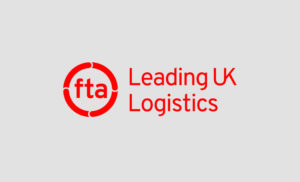
World Toilet Day:
HGV drivers deprived of human right to sanitation
12:00 Tue 19th Nov 2019 | Posted By UKHAULIER EDITOR
Many of the UK’s HGV drivers are deprived of the United Nations (UN) Human Right to sanitation due to the lack of toilet facilities on the national road network, according to FTA, the voice of the UK logistics sector. Speaking on the UN’s World Toilet Day (19 November 2019), FTA is renewing its calls for government to prioritise the provision of sufficient welfare facilities for professional drivers across the UK.
Elizabeth de Jong, Director of UK Policy at FTA, comments: “The logistics sector is the lifeblood of the UK economy, ensuring businesses, schools and hospitals are all stocked with the goods they need to operate. But despite the invaluable contribution HGV drivers provide to the economy, they are often denied access to very basic amenities. The inconsistent provision of toilets and other facilities for HGV drivers across the road network is not good enough; access to hygiene amenities and other welfare services are a basic right for all workers. No other industry would be expected to work without access to toilets, so why should HGV drivers?
“More than 18 months ago, the government vowed to improve and expand the provision of facilities for those charged with keeping Britain trading, but since that promise, amenities have actually become worse. Nearly all the respondents to a survey conducted by FTA of its member organisations felt there had been no improvement in the facilities for drivers on local roads, and over half of them felt that the provision had become worse over the last 12 months. In an industry where you are compelled by law to take regular breaks and rest, it is vital drivers have access to these most basic facilities.”
![]()
The NEW Standard Toilet
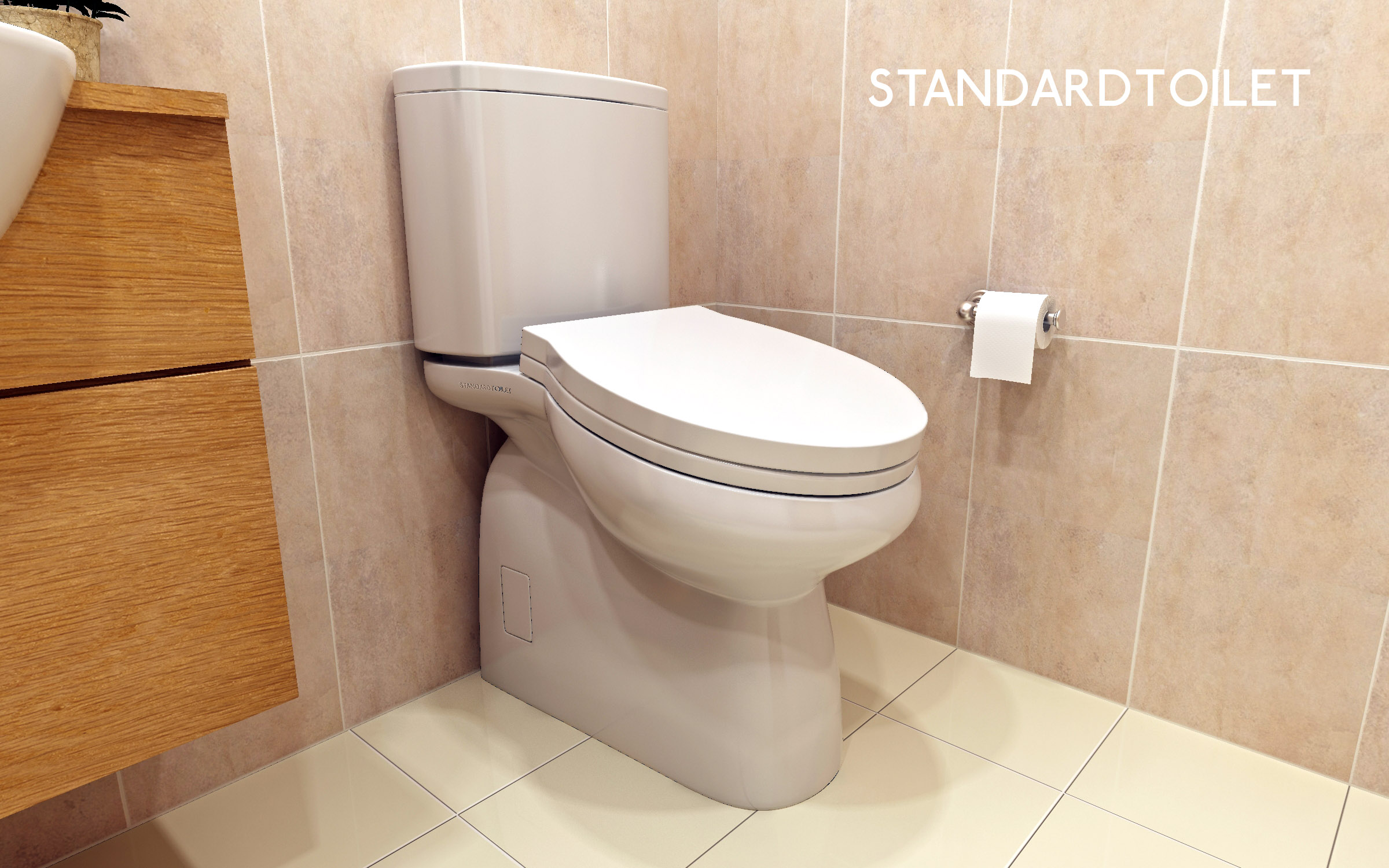
PRESS RELEASE:
“SLANTY” Innovation
in Toilet Design
www.standardtoilet.net
It is estimated that in the United Kingdom alone, extended employee breaks costs
industry and commerce an estimated £4 billion per annum. With the advent of flexible zero hour contracts
it is easy to see why our StandardToilet can be an asset to a business.
Our unique Patent Application, applicable both UK and worldwide, offers the ability to increase business efficiency and profits through reductions in social media usage.
The – Problems – with – modern – day – Toilets
Medical studies have suggested that it can cause swollen haemorrhoids and
weakening of pelvic muscles.
In modern times , the workplace toilet has become private texting and social
media usage space.
In commercial shopping malls and train stations, a requirement to reduce queuing
has become a necessity.
Innovation – Product Design
Health & Wellbeing
Medical studies have suggested that using the traditional WC can cause swollen
haemorrhoids and weakening of pelvic muscles. *
* NHS- UK Guidance Notes *Harvard Medical School
WALL MOUNTED MODEL WM1002 & WM 1004
Specification
- Easy to clean glazed ceramic
2. Soft Close toilet seat option
3. Water saving 3/6 Litre Dual Flush
4. Available in White/Grey
5. Suite includes concealed cistern
6. Specially designed slots in the rim allow for a more uniform, quieter flush
7. Ceramic is high-pressure cast, yielding a more uniform and consistent product
8. Easy sit on / get up design
9. Health Benefits – Reduction in haemorrhoids/musculoskeletal disorder
Reduce queuing
Current toilet seats provide a horizontal seating surface. This enables a user to sit
relatively comfortably on the toilet. As a result, a user may spend longer than
necessary sitting on the toilet without short-term discomfort. Sitting on a toilet for
longer than is necessary is generally undesirable.
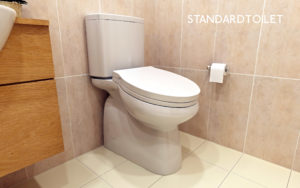
FLOOR MOUNTED MODEL FM 1001 & FM 1003
Specification
1. Easy to clean glazed ceramic
2. Soft Close toilet seat option
3. Water saving 3/6 Litre Dual Flush
4. Available in White/Grey
5. Cistern sits directly on the pan surface allowing the direct transfer of water
6. Specially designed slots in the rim allow for a more uniform, quieter flush
7. Ceramic is high-pressure cast, yielding a more uniform and consistent product
8. Easy sit on / get up design
9. Health Benefits – Reduction in haemorrhoids/musculo-skeletal disorder
Benefits to Disabled Toilet users: By using our uniquely designed WC, the time spent on the WC is considerably reduced, easing queuing congestion and benefitting by reduction in overspill usage
of disabled facilities.
Applications
Office & commercial buildings
Shopping malls
Public spaces
Motorway service stations
Pubs & restaurants
Sports events, theatre & concert halls
Seaside resorts
Patent Details:
Patent Attorneys – Swindell & Pearson Ltd
Swindell & Pearsons file No: RPL/SP/44435GB
United Kingdom Patent Application No. 1909327.7
Business case Details and
Contact Details:
Website: www.standardtoilet.net
Royal Society for Public Health (RSPH)
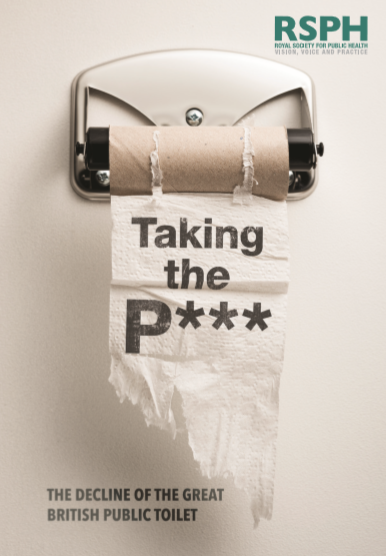
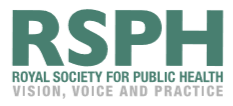
REPORT ON THE SERIOUS DECLINE OF PUBLIC TOILETS
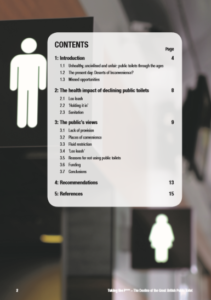
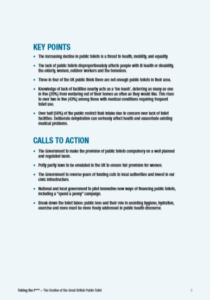
1: Introduction
1.1 Unhealthy, uncivilised and unfair: public toilets through the ages Provision of toilets outside the home dates back to ancient times, although the modern history of these facilities is from the late 19th century. Old-style toilets, often termed ‘nuisances’, drained directly into rivers or streets: these were removed from UK cities from the mid-19th century onwards. The problem for an increasingly mobile population was that such facilities, however unsatisfactory, were not usually replaced. The emphasis was on cleaning up the environment and there was little or no concern for the working classes lacking access to toilets. There was also an assumption that, with homes increasingly having toilets (albeit often outside or shared in poor communities), there would be natural progress in sanitation. The Great Exhibition of 1851 presented the public with flushable water closets that proved both popular and profitable, but a trial of the economic feasibility of public toilets by the Royal Society in 1852 made a large loss.
Nevertheless, the idea that public toilets could and should be profitable has persisted, associated with an implied assumption that these are optional luxuries, with no legislation requiring public toilets on the UK statute books. In a study of the heyday of public toilets at the turn of the last century, the most prominent block to provision was funding, as it is now.1 In the latter half of the 19th century a few public places, such as railway stations, installed toilets; but there were still no street facilities for women, and provision in workplaces was inconsistent – again with usually none for women. Prompted by lack of facilities and concerns about street urination, the 1880s onwards saw installation of public toilets in most UK cities, often with grand architectural design, celebrating the newly established improvements in plumbing and sewerage. Legislation was introduced for required provision in workplaces and schools, but not elsewhere.
Figure 1 – A former public toilet in Spitalfields, London, converted into a wine bar and put up for sale again in 2016 for £1 million.
During the first half of the 20th century, public toilets continued to increase in number, funded usually by local authorities (LAs). Some were free to use, but many required payment. The charge was one old penny until decimalisation of the currency in 1971, but usually there was a free cubicle for those without a penny to hand or to spare, a feature which has since disappeared.
In more recent decades the increasing pressure on LA budgets has led to the privatisation or closure of many public toilets. Sub-contracted or privately operated toilets make a charge, usually 50p or more. They tend to be located in highly frequented areas such as tourist spots and in general they have restricted opening hours. Legislation from the 1960’s banning turnstiles – on the basis that they are unfair to the disabled, as well as to those without money – has since been repealed to allow ‘pay to enter’ facilities. Where public toilets cannot be privatised, many have been sold off for other purposes or simply closed (Figure 1). Introduction of legislation to improve disabled access has had the unfortunate consequence in some cases of several public conveniences being replaced by just one disabled access toilet. On top of this, many of the required accessible toilets are not fit for purpose or are inconveniently located. Sporting venues are also poorly served, with particular problems for the disabled.
1.2 The present day:
Deserts of Inconvenience? According to a BBC report in 2016,3 local council cuts caused one in seven public toilets to be closed between 2010-13, the UK situation being described as “deserts of inconvenience” from “Wandsworth to Newcastle”. The report identified ten areas in England and Wales with no council-run public toilets at all. In a further BBC report in 2018,5 this loo absence had increased to 37 areas of the UK. This should come as no surprise given four out of five councils cut spending on public toilets between 2011 and 2016,3 a trend that shows no sign of reversing. While the few public toilets available do tend to be found more frequently in tourist areas, the shortage of ‘places to go’ for large groups has become a major concern for tourism, now a major income generator for the UK. Workers ‘on the move’, such as tourist guides, drivers of lorries or buses and postal workers, have often complained in vain of the lack of facilities.
Equality of access to toilets is an important factor, particularly for women who take longer and cannot use urinals. This leads to the long queues familiar in many public toilets (Figure 2). In a YouGov UK survey in 2017, 59% of women reported that they regularly queue for a toilet, compared with 11% of the men.7 Because of time consuming factors related to clothing, menstruation, and anatomical differences, a fair ratio of toilet provision would be at least 2:1 in favour of women. Calls to address this unfairness have led to ‘potty parity’ legislation in some US states and Canada,8 although not yet in the UK, where the British standard is still 1:1, despite a recommendation from the British Toilet Association for at least as many female cubicles as there are cubicles and urinals in male toilets.9 Equality of access includes the demands for ‘gender neutral’ toilets and the needs of transgender individuals.10
Local council cuts caused one in seven public toilets to be closed between 2010-13
In an age when previously shocking topics are readily discussed and aired in the media, there persists a reticence about either discussing public toilets or acknowledging the increasing problem of their absence. The most recent House of Commons public inquiry into toilets in 2008 referred to the taboo still surrounding the subject11 and this is further demonstrated by various euphemisms for these facilities, such as cloakrooms, rest rooms or conveniences. Low priority is given to planning and ensuring appropriate provision, and it is a great shame that the issue has been side-lined in this way. In fact, failure to provide public toilets has implications not just for sanitation and general convenience, but also for levels of social isolation and physical activity among certain groups, through restricting their ability to go outdoors.
UK public inquiries in this century have lamented the decline in public toilets,11,12 while coming up with few practical solutions, save for community toilet schemes, whereby local cafes and other establishments receive modest funding to allow people to use their toilets without having to buy anything. Such schemes are suitable mainly for individuals: while they undoubtedly add to the provision of facilities, they do not address the needs of groups, many of the disabled or most of the homeless.
Figure 2 – Women queuing at the Embankment public toilets, London These toilets were first erected in 1911 with the aim of reducing “nuisances committed in doorways and the public street”. There is now a charge for entry. Note no queue for the ‘Gents’ on the left side. Photo: R. Stanwell-Smith
[BBC, 2018] In 2010 there were 5,159 toilets run by major councils in the to 4,486 in 2018
1.3 Missed opportunities
While there have been some hard won improvements to policy and British Standards on toilets,13,14,15 Wales is the only part of the UK with a new Public Health Act requiring local authorities to publish a local toilets strategy for its area. The ‘Inconvenience Committee’ of professional tourist guides successfully campaigned for the large Unite Union to pass a demand for statutory provision of public toilets a decade ago, although this has yet to be acted upon.
A recommendation that all the new Crossrail stations in London should have accessible toilets has not yet been fulfilled, with the admission that some key points, such as the busy Bond Street station, will have no toilet facilities whatsoever. While in 2017 the Mayor of London announced that in the draft London plan, more public toilets will be provided for London’s diverse population,17 there has been no recent update on progress. The recent good news that some London stations will allow free access to the toilets within station precincts is welcome – but as yet there is no indication this will apply in all stations.
The international perspective on toilets focuses on the World Health Organisation’s goal of universal basic sanitation by 2030, and we must not forget that with most UK homes having at least one toilet, we are better off than many parts of the world. World Toilet Day (November 19th) is now a regular reminder of the 2.3 million people who lack access to a clean and safe toilet, an improvement on the 2.6 billion in this plight in 2010 but slow progress nonetheless. While the international priority therefore is directed to ensuring toilets within the home, in many regions people will only have access to public toilets in the foreseeable future, or no toilets at all. Even when most homes in the world have a toilet, there will still be a need for public facilities, just as there is in the UK.
Provision of toilets has been called “the barometer of civilisation” and the UK should continue to support the international efforts required – but also must address the current state of neglect for public toilets we see in this country today.
The Global Picture
2: The health impact of declining public toilets
2.1 Loo leash
Most of us need a public toilet occasionally, but this is a more urgent problem for those with medications or medical conditions causing increased frequency of the need for a toilet (such as diabetes, or bladder, bowel or prostate conditions). In addition to diagnosed conditions, advancing age increases the need, as does the requirement for nappy changing and young children who can’t wait. Knowledge of the lack of facilities nearby acts as a ‘loo leash’, deterring some from venturing far beyond their homes. It is deeply concerning that at a time when public health policy is to encourage outdoor exercise, partly to reduce obesity and also to keep our increasingly elderly population fit and engaged with the community, our declining public toilet provision is in fact encouraging more people to stay indoors.
2.2 ‘Holding it in’
Deliberate dehydration or ‘holding it in’ to reduce the need for a toilet is commonly practised by those who fear not being able to find a public loo, but this can seriously affect health and exacerbate existing medical problems such as cystitis (Figure 3). Water bottle refilling points have been installed in several places in the UK, but public toilets would provide an ideal location, with the advantage of frequent water flow to prevent stagnation and possible contamination, a problem that has rendered many old-style drinking fountains impossible to maintain hygienically.
2.3 Sanitation
The health impact of public toilet closures includes the problems of street urination and defecation. Bye-laws prohibiting public urination do not exist for over half the LA’s in the UK, and where they do they are rarely enforced. It is difficult to estimate the hygiene impact of this but it is insanitary to have contact with faeces or urine, the contamination not always being clearly visible. This is a particular risk to young children and wheelchair users. Add to this the lack of hand washing points, for people eating out of doors or when travelling, and you have the potential for contamination by pathogens causing individual illness or contributing to epidemics. In poor areas in the US, emergency installation of public toilets and washing facilities has been used to control outbreaks of dysentery and hepatitis, such as on Skid Row in Los Angeles.
Figure 3 – Health effects of deliberate dehydration
Health effects of deliberate dehydration
Weakness, dizziness, reduced physical performance, reduced short-term memory and other cognitive performance, depressed mood, less alert
constipation, cystitis, increased risk of renal stones and headache
3: The public’s views
In September 2018 a questionnaire survey was conducted for RSPH on what the public think about the decline in toilets, as well as ideas for how toilets could be funded, health implications, and access implications for women. Conducted by Populus, the survey included 2,089 UK adults aged 18 or over, with a standardised data base to represent factors such as income, gender, age and region.
3.1 Lack of provision
Given the rate of closures, it is unsurprising that 74% of people reported that there are not enough public toilets, with an increasing proportion by age
(Figure 4). There was some overall regional variation, with a range of 65% (E Midlands) to 82% in Wales and NW England. For those who need a toilet frequently due to illness or other condition (19% in this survey), the percentage reporting not enough public toilets was 85%. Regarding location of toilets, over 60% reported that there are insufficient public toilets in parks, although this figure was above 30% for other places, such as tourist areas and shopping centres (Figure 5). The majority of women and men in the survey (84% and 69% respectively) agreed there should be greater provision of toilets for women, although only 25% of the women and 30% of the men thought that toilets should be unisex to reduce queues. For the latter question there was an inverse relationship with age, with 38% of younger people (18-24 years) favouring the unisex toilet option, compared with 26% of those aged 65 years or more.
• Three in four (74%) of the public say that there are not enough toilets in their area
• One in five (20%) don’t feel able to go out as often as they like
• More than half of us (56%) restrict our fluid intake before going out to reduce the need to find a toilet
Not enough public toilets?
% by age group 100 80 60 40 20 0 18-24yrs 35-34yrs 35-44yrs 45-54yrs 55-64yrs 65yrs
Figure 4 – Percentage of responders by age who stated there are not enough public toilets
3.2: Places of convenience
When people in the survey could not find a public toilet, supermarkets were a popular option (70%), followed by cafés or restaurants (63%). A smaller proportion resorted to pubs, petrol stations and betting shops, but of greater concern was the 16% who use a back alley or bush, this percentage being higher for men and for those with a frequent need for a toilet (Figure 6). Seventy-one percent of women reported that they never did this, compared with 41% of the men. Nearly a third of all areas combined (29%) reported that street urination was a problem in their town; 45% reported this for the London area.
Where do we need more public toilets?
% survey
% respondents
0 10 20 30 40 50 60 70
MEN WOMEN
Figure 5 – ‘No’ responses to question about whether there are enough public toilets in particular locations.
Figure 6 – Percentage of men and women reporting use of a back alley or bush when no public toilet is available
Residential areas Tourist areas Shopping centres Bus stations Tube stations Railway stations Parks
80 70 60 50 40 30 20 10 0
Never Ever Several times/yr
% respondents 0 20 40 60 80
Figure 7 – Reasons given for not using a public toilet, by gender
Concerns re safety
Concerns re drug use
Cost of entry
Lack of loo paper
Smell bad
Often unclean
Women Men
% respondents
3.3: Fluid
Over half the public restrict fluid intake in case they can’t find a toilet. Fifty-six percent of survey respondents reported restricting fluid intake either occasionally or frequently, due to concern that they might not find a toilet. Eleven percent reported that they restricted fluids more than once a week, rising to 13% among women compared to 9% of men. The highest proportion by social grade was in the semi skilled/unskilled group, with 15% reporting that they had to do this regularly.
3.4: ‘Loo leash’
The term ‘loo leash,’ sometimes also called a ‘urinary leash,’ refers to being unable to stray far from home, in case no toilet can be found. Two in five (42%) respondents reported that they have restricted outings on this basis, including 4% who have to do this more than once a week.
Strikingly, one in five of the general public agreed that they are ‘not able to go out as often as [they] would like because of concerns around a lack of public toilets.’ For those with an illness or condition requiring more frequent toilet use, this figure rose to above two in five (43%). Altogether these are alarming statistics with regard to health impact, and not insignificant obstacles to wider attempts to curb obesity, increase fitness and reduce health inequalities.
3.5: Reasons for not using public toilets
Some public toilets are excellent, well maintained and with an attendant on duty. Sadly this is not always the case and reasons given for not using a public toilet included lack of cleanliness, bad smell or lack of toilet paper, cited more frequently by women. There were also concerns about safety, drug use and cost
(Figure 7). restriction
3.6: Funding
The running costs of public toilets, according to local authority and other reports, vary between around £15,000 and £60,000 a year, depending on factors such as size and staffing by attendants. In the survey we attempted to tease out some viable options for funding, given the majority response that there should be a lot more public toilets.
Despite the consensus about need, few want to pay for them from their own pockets. For example, 85% agreed that councils (LAs) should have “a legal responsibility to provide public toilets which are free to use for the public”, but only 34% agreed that this should be via raising council tax. Such a proposal would also be unworkable without significant changes to the funding environment, following years of central government cuts to local authority budgets.
Between 2010 and 2020, councils will have lost almost 60p out of every £1 the Government had provided for services [LGA, 2019]. Unsurprisingly, the least popular option for funding public toilets was by entry fees (30%), but none of the offered options proved universally popular, with the exception of advertising in toilets (78%).
Business or charity sponsorship (62%), a generous benefactor (60%) and state funding in tourist areas (67%) were favoured. While benefactors do occasionally come forward, for instance for the toilets in Bridport, Dorset, funded by a local business woman, this is not a sustainable funding model at scale. Nevertheless, given the shortage of national or LA funds for these ‘necessaries’, it may be possible to offer tax breaks or gift aiding schemes to encourage both companies and individuals to sponsor local public toilets schemes.
The idea of taking a penny from the price of a bus, train or tube ticket was favoured by 45% of the public, while a tax on cafés and bars had the support of just over half (51%). State funding of toilets in tourist areas is not a new idea and local funding of this type is used in other countries, such as the USA.
3.7: Conclusions
Public toilets should be considered as essential as streetlights, roads and waste collection, and equally well enforced by legislation and regulations. This is important for all countries: the huge task of improving global sanitation should not eclipse the need for public toilets. The lack of provision is affecting equality, mobility, physical fitness and other aspects of health. However, our survey also demonstrated a central problem – no one wants to pay for them. It is high time to consider potential solutions.
4: Recommendations
I. The Government to make the provision of public toilets compulsory on a well planned and regulated basis. The time is right to deal with the astonishing lack of legal action on public toilets provision, as a matter of urgency – and for all those for whom urgency of need has not been addressed. This could be done through minor amendments to existing ‘permissary’ legislation, for example the most recent Public Health Act (1936). Where cities such as London have included public toilets in their plans, it may be possible to offer help and publicity to ensure that these are followed through without further delays.
II. Potty Parity Alongside this, ‘potty parity’ laws (as exemplified in the US, Canada and elsewhere [NY Times, 2005]) should be emulated in the UK to ensure fair provision in all areas. Equality of access to toilets includes the need for more unisex facilities, more toilets for women, and taking into account the needs of transgender individuals.
III. The Government to reverse years of funding cuts to local authorities and invest in our civic infrastructure.
A crucial prerequisite for the introduction of such statutory requirements regarding public toilets is the adequate resourcing of local authorities by central government. Councils are undergoing a financial crisis as a result of years of chronic under-funding: analysis by the Local Government Association shows that local services will face a funding gap of £3.9 billion by 2019/2020, rising to £7.8 billion by 2024/25 [LGA, 2019]. A proper funding settlement for local authorities is vital for ensuring adequate levels of public toilets provision, as well as positively influencing many other upstream determinants of health. The Government should use the forthcoming Spending Review to reverse years of shortsighted funding cuts, and properly resource local authorities.
Council Passes a Bill to Shorten the Line at the Ladies’ Room, New York Times Nicholas Confessore, May 26, 2005, accessible https://www.nytimes.com/2005/05/26/nyregion/council-passes-a-bill-to-shorten-the-line-at-the-ladies-room.html
IV. National and local government to pilot innovative new ways of financing public toilets, including a “spend a penny” campaign.
Recognising that public inquiries have failed to identify public toilets as a state or local funding priority, other ways to raise money to pay for toilets should be urgently considered, such as: • ‘Spend a penny’ levies on travel – a one-penny drawn from the price of every train and bus ticket to finance public toilets in the local area. This approach could be tailored to different regions, but as a rough indication of what it could finance in the capital, taking a penny on every London bus and tube journey corresponds to nearly 700 fully funded facilities – more than 20 new public toilets for every borough. • Donations on purchases, building on the success of this tactic by some charities and the successful introduction of a charge for plastic bags. • Sponsored activities and events. • Tax breaks for major donations to build or sustain a public toilet. • More advertising and optional purchases within public toilets or nearby.
V. Break down the toilet taboo
The taboo in discussing the serious aspects of toilet provision should be tackled by raising the profile of the subject, for example: • A conference in collaboration with charities that have sought to publicise the ‘toilet problem’. • Inclusion of the issue in fund raising events such as Red Nose Day and sponsored activities for charity, with emphasis on the health and social impact of the lack of provision. • An architectural competition to design the best public toilet in the UK – a ‘convenience’ suitable for our times – which could also serve as a tourist attraction. • A competition to find the best toilet jokes or limericks, to be publicised along with the lack of public toilets. The toilet taboo has led to a lack of public debate on the importance of this population health issue, and the way it disproportionately disadvantages certain groups, such as older people, women, and those with existing health conditions. Public health organisations have a responsibility to ensure the health effects of declining provision are publicised more widely, and that public toilets are recognised for their potential role in assisting hygiene, hydration, mobility and exercise. • All strategies and reports on obesity or physical activity to include reference to or recommendations on the levels of public toilet provision in parks and public areas. • Health aspects of deliberate dehydration or inadequate provision for those with greater need should be highlighted in reports on health and disability.
1. Stanwell-Smith R. Necessary nuisances: public health and the public toilet in London 1890-1910. Dissertation for the Diploma in the History of Medicine, Worshipful Society of Apothecaries, June 2011. 2. Photo Clarke & Lloyds property consultants – sourced from https://www.standard.co.uk/news/london/ money-down-the-drain-expublic-toilet-on-sale-for1-million-in-spitalfields-a3158681.html (accessed 02.05.2019) 3. BBC news online. Public toilets ‘wiped out in parts of UK’. Online: https://www.bbc.co.uk/news/uk36405414 4. Frizzell N. UK Councils are selling off public toilets. We need a loo coup. The Guardian, Thursday 6 June 2016. available at https://www.theguardian.com/ commentisfree/2016/jun/02/councils-selling-publictoilets-loo-coup (20.05.19) 5. Jones L, Schraer R. BBC Reality check: public toilets mapped. 15 August 2018. Online: https://www.bbc. co.uk/news/uk-45009337 6. Truckers’ Toilets UK. Newsletter for lorry drivers produced by Gillian Kemp. www.facebook.com/ TTUKcampaign 7. Smith M. Potty parity: would it be fairer to make women’s toilets bigger? [YouGov survey December 2017]. https://yougov.co.uk/news/2018/03/20/pottyparity-would-it-be-fairer-make-womens-toilet/ 8. Anthony KH, Dufresne M. Potty parity in perspective: gender and family issues in planning and designing public rest rooms. Journal of Planning Literature 2007; 21(3): 267-294 https://yougov.co.uk/topics/ politics/articles-reports/2018/03/20/potty-paritywould-it-be-fairer-make-womens-toilet 9. Ratio of male to female toilets, 2012. https://www. northernarchitecture.us/sport-architecture/ratio-ofmale-to-female-toilets.html 10. Davis AK. The hidden privilege in ‘Potty Politics’. American Sociological Association 2017 https://journals.sagepub.com/ doi/10.1177/1536504217732051?icid=int.sjabstract.similar-articles.3
11. House of Commons Communities and Local Government Committee. The provision of public toilets. London: The Stationery Office Ltd. October 2008 https://publications.parliament.uk/pa/ cm200708/cmselect/cmcomloc/636/636.pdf 12. Greater London Authority. An urgent need: The state of London’s public toilets. The London Assembly Health and Public Services Committee, March 2006. No longer available online, see Update Report July 2011. http://www.btaloos.co.uk/wp-content/ uploads/2014/01/FINAL_HPS_public_toilets_update_ report.pdf 13. Greed C. Inclusive urban design: public toilets. 2003. Oxford: Architectural Press. 14. Barkley M, Greed C. British standards revisions: more toilets for women and better toilets for all. Bathroom Today 2006; 2:42-43 15. Greed C. Overcoming the factors inhibiting the mainstreaming of gender into spatial planning policy in the United Kingdom. Urban Studies 2005; 42(4): 719-49 16. Cunningham S. Public In-conveniences. A practical guide to improving standards. Update September 2018. Online: http://www.publicinconveniences.org. uk/authors-comments/ 17. 17th Mayor’s Report to the Assembly. December 2017, pp26-27. Online: https://www.london.gov.uk/ sites/default/files/17th_mayors_reportv2.pdf 18: NHS Inform, Symptoms of dehydration, available at https://www.nhsinform.scot/illnesses-andconditions/nutritional/dehydration#symptoms-ofdehydration (accessed 20.05.19)” 19: Water, Hydration, and Health, Barry M. Popkin, Kristen E. D’Anci, Irwin, H. Rosenberg; Nutr Rev. 2010 Aug; 68(8): 439–458 20. CBS news report 2017. Online: https://losangeles. cbslocal.com/2017/10/18/portable-restroomshepatitis-a-outbreak/ accessed 20.05.19 21. Approximation based on the upper estimate of facilities running costs of £60,000 per year, and TFL data on journeys per year (accessible at https:// www.london.gov.uk/sites/default/files/bus_network_ report_final.pdf and https://tfl.gov.uk/corporate/ about-tfl/what-we-do/london-underground)
5: References
This report was lead-authored by Dr Rosalind Stanwell-Smith, trustee of the Royal Society for Public Health and Honorary Senior Lecturer at the Centre for History in Public Health, London School of Hygiene and Tropical Medicine.
The Royal Society for Public Health
John Snow House,
59 Mansell Street,
London, E1 8AN
www.rsph.org.uk
May 2019
For more information, please contact Toby Green – tgreen@rsph.org.uk
© RSPH 2019 Charity Registration Number 1125949
Twitter: @R_S_P_H Facebook: Royal Society for Public Health LinkedIn: Royal Society for Public Health








